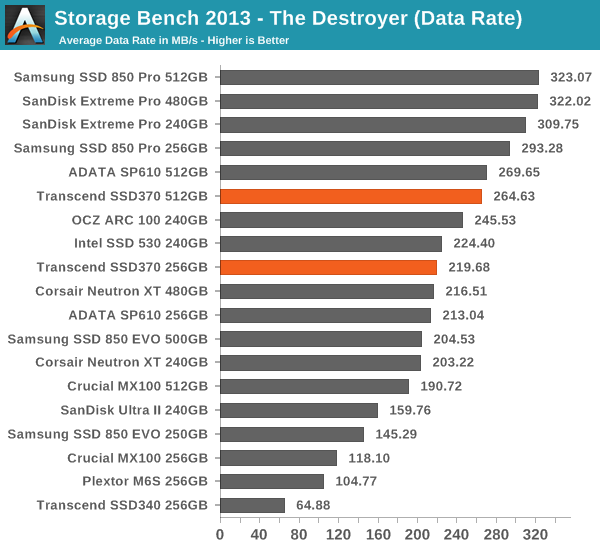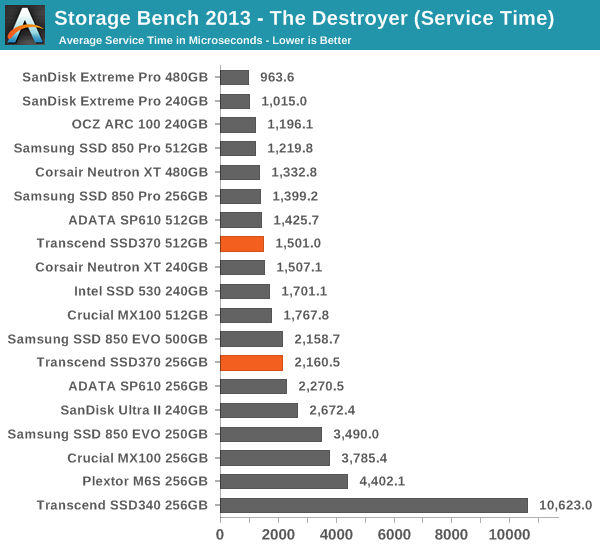Transcend SSD370 (128GB, 256GB & 512GB) Review
by Kristian Vättö on January 27, 2015 8:00 AM EST- Posted in
- Storage
- SSDs
- Transcend
- Silicon Motion
- SM2246EN
AnandTech Storage Bench 2013
Our Storage Bench 2013 focuses on worst-case multitasking and IO consistency. Similar to our earlier Storage Benches, the test is still application trace based – we record all IO requests made to a test system and play them back on the drive we are testing and run statistical analysis on the drive's responses. There are 49.8 million IO operations in total with 1583.0GB of reads and 875.6GB of writes. I'm not including the full description of the test for better readability, so make sure to read our Storage Bench 2013 introduction for the full details.
| AnandTech Storage Bench 2013 - The Destroyer | ||
| Workload | Description | Applications Used |
| Photo Sync/Editing | Import images, edit, export | Adobe Photoshop CS6, Adobe Lightroom 4, Dropbox |
| Gaming | Download/install games, play games | Steam, Deus Ex, Skyrim, Starcraft 2, BioShock Infinite |
| Virtualization | Run/manage VM, use general apps inside VM | VirtualBox |
| General Productivity | Browse the web, manage local email, copy files, encrypt/decrypt files, backup system, download content, virus/malware scan | Chrome, IE10, Outlook, Windows 8, AxCrypt, uTorrent, AdAware |
| Video Playback | Copy and watch movies | Windows 8 |
| Application Development | Compile projects, check out code, download code samples | Visual Studio 2012 |
We are reporting two primary metrics with the Destroyer: average data rate in MB/s and average service time in microseconds. The former gives you an idea of the throughput of the drive during the time that it was running the test workload. This can be a very good indication of overall performance. What average data rate doesn't do a good job of is taking into account response time of very bursty (read: high queue depth) IO. By reporting average service time we heavily weigh latency for queued IOs. You'll note that this is a metric we have been reporting in our enterprise benchmarks for a while now. With the client tests maturing, the time was right for a little convergence.

What surprises me is that the SSD370 does so well in the 2013 Storage Bench even though its IO consistency is leaves a lot to be desired. Again the performance is a very close match with the SP610 and overall the SSD370 is a fairly capable middle-class performer.











44 Comments
View All Comments
danko358 - Wednesday, September 23, 2015 - link
Compared to other SSDs power consumption of SSD370 is high, as seen in review. What about comparing it to regular HDDs? As I understand, it's the same. I'm asking because I'm considering replacing regular HDD in my laptop with SSD370 256. So my battery life will remain the same? It won't be shortened?amirzz - Thursday, December 24, 2015 - link
Hithis is to inform all concerned, I don't get in what technology transcend SSD370 is made up of...
I've recently bought one of this & now after keeping a backup of my crucial data here...
one folder containing my tutorials is not respondins as needed... I don't seem to find any solutions anywhere in the net....
so plz experts in ssd help me here...
my email: neobondhu[at] gmail[dot] com
Firedrops - Monday, February 29, 2016 - link
You really should provide screenshots of actual capacities in these reviews. There can be easily ~10GB difference in capacity between brands/models even when labelled similarly, at ~240-256GB capacities.lenberg - Thursday, September 15, 2016 - link
Does anyone know how to align partitions in this ssd properly?What are the NAND Erase Block Size and NAND Page Size?
Thanks in advance.